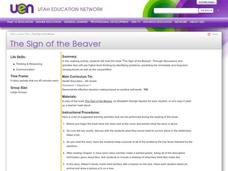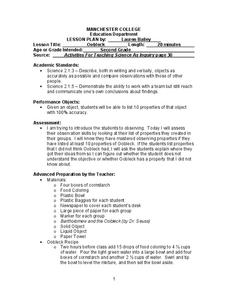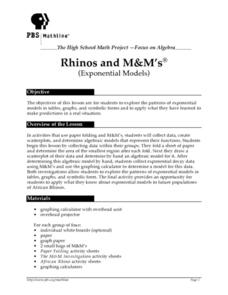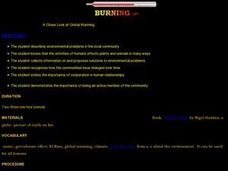Curated OER
Microbial Contaminants in Drinking Water
When presented with three unopened bottles of water, high schoolers are asked to tell decide which one is contaminated with a microbe. Students work in small groups and role play being a Microbiologist, a patient, or a recorder. The...
Curated OER
Poetry in Weather
Young scholars observe and identify the various types of clouds. They compare clouds to clouds on a chart, and in small groups compose and present a group poem about clouds and weather.
Curated OER
The Sign of the Beaver
Fourth graders read the book "The Sign of the Beaver". As a class, they identify the problems in the story and predicting what they think is going to happen next. Individually, they examine the cause and effect relationships and...
Curated OER
Oobleck
Second graders observe the properties of Oobleck. In this science and observation instructional activity, 2nd graders examine Oobleck and make a list of 10 properties that they notice. They explain their observations.
Curated OER
Polar Bear, Polar Bear, What Do You Hear? Lesson Plan
Students use technology and listening skills to explore the sounds of their environment. In this environment observation lesson, students read Polar Bear, Polar Bear, What Do You Hear? in order to identify the sounds in the story; these...
Curated OER
Snowy Days
Students explore the book "The Snowy Day" by Ezra Jack Keats. They predict what the story is about and predict what will happen in the story. Students write their own endings for the story.
Curated OER
Which Amusement Park Would You Choose?
Students analyze data related to amusement parks and create a spreadsheet to display the data. They read the data and predict which amusement park they think is safer, create a spreadsheet and graph, and write a proposal based on their...
Curated OER
Exercise and Water
Second graders discover the needs of their body by trying different types of aerobic exercise. In this physical education lesson plan, 2nd graders analyze The Busy Body Book by glancing at the pictures inside and predicting what the...
Curated OER
U.S. And Global Deforestation
Young scholars analyze graph showing global deforestation, view photograph of deforestation in Brazil's interior rain forest and examine three maps showing deforestation within the United States, describe political, economic, and social...
Curated OER
Tall Tale
In this tall tale worksheet, students read a tall tale about a pig named Porter. Students finish the story on a separate piece of paper.
Curated OER
2004 Better and For Worse
Students identify the significant events that helped shape 2004. After reading an article, they take a 2004 news quiz and discuss the impact of each event. They create their own quizzes to be given to their classmates on the same...
Curated OER
Rhinos and M&M's
Students analyze patterns of exponential models by collecting data in paper folding and M&M investigations. They use graphing calculators to create scatter plots that lead to equations for the exponential models. They then apply this...
Curated OER
Weather: You Like It or Not
Students explore the importance of and flaws in weather prediction, and prepare their own weather report on a specific type of storm.
Curated OER
Introducing the Memo
Students explore memos to gather important information. In this memos lesson, students interpret memos and answer questions based on the information. Students define the parts of a memo. Students create their own memos.
Curated OER
Burning Up! A Look at Global Warming
Students investigate global warming. In this global warming lesson, students watch movies about global warming, discuss problems in their local community and see how communities have changed over time. Students realize the importance of...
Curated OER
Too Much of a Sweet Thing
Students examine the growing prevalence of processed sugar in the American diet, first through a demonstration that makes graphically clear the amount of sugar an average boy and girl consumes on a daily basis.
Curated OER
Problem Solving
Second graders practice problem solving strategies. In this problem solving instructional activity, 2nd graders use strategies such as guess and check, acting out, drawing pictures and looking for patterns to solve problems. Students...
Curated OER
The Drum
Students complete a variety of activities related to the folktale from India, "The Drum." They listen to the story and answer comprehension questions, construct a coffee can drum, and complete a phonics and matching worksheet.
American Chemical Society
Density: Sink and Float for Liquids
We don't think of liquids as floating typically, but a quick look at any oil spill tells a different story. Lesson explores various densities of liquids and why this fact is important. After observing the density variation, scholars...
Science 4 Inquiry
Investigating How Heat Flows
It is impossible to cool down a glass of water by adding ice. Young scientists explore heat transfer through videos, experiments, and interactive games. They quickly catch on that the water melts the ice and things aren't always as they...
Science 4 Inquiry
Layers and Laws: The Law of Superposition and Index Fossils
What can layers of rock teach us about the climate? Young scientists solve a mystery about who stole a cookie by applying the law of superposition. Then, they apply the same concept to solve a more difficult mystery, trying to determine...
Bright Hub Education
Introducing "Number the Stars"
Prepare your class to read Number the Stars, by Lois Lowry, with these prereading activities. This resource lists three ideas to ready your readers. Learners explore the historical context, connect to the book, and preview the book....
Curated OER
How We Feel
Students examine how their feelings make them unique. They read and discuss a poem, develop a list of feelings, and create a drawing of them feeling happy and healthy.
Curated OER
The Great Kapok Tree..
Students predict what each animal in the story read says and then compare them. They pretend that a tree was cut down and write a new ending for the story. Students explain why the story is not true and create a Venn Diagram comparing...

























